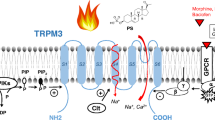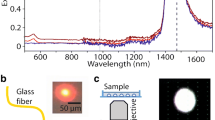Abstract
The sensing of hot and cold stimuli by dental neurons differs in several fundamental ways. These sensations have been characterized quantitatively through the measured time course of neural discharge signals that result from hot or cold stimuli applied to the teeth of animal models. Although various hypotheses have been proposed to explain the underlying mechanism, the ability to test competing hypotheses against experimental recorded data using biophysical models has been hindered by limitations in our understanding of the specific ion channels involved in nociception of dental neurons. Here we apply recent advances in established biophysical models to test the competing hypotheses. We show that a sharp shooting pain sensation experienced shortly following cold stimulation cannot be attributed to the activation of thermosensitive ion channels, thereby falsifying the so-called neuronal hypothesis, which states that rapidly transduced sensations of coldness are related to thermosensitive ion channels. Our results support a central role of mechanosensitive ion channels and the associated hydrodynamic hypothesis. In addition to the hydrodynamic hypothesis, we also demonstrate that the long time delay of dental neuron responses after hot stimulation could be attributed to the neuronal hypothesis—that a relatively long time is required for the temperature around nociceptors to reach some threshold. The results are useful as a model of how multiphysical phenomena can be combined to provide mechanistic insight into different mechanisms underlying pain sensations.





Similar content being viewed by others
References
Oskui, I.Z., Ashtiani, M.N., Hashemi, A., et al.: Effect of thermal stresses on the mechanism of tooth pain. J. Endod. 40, 1835–1839 (2014)
Lin, M., Genin, G.M., Xu, F., et al.: Thermal pain in teeth: electrophysiology governed by thermomechanics. Appl. Mech. Rev. 66, 031001 (2014)
Kim, Y.S., Kim, T.H., Mckemy, D.D., et al.: Expression of vesicular glutamate transporters in transient receptor potential melastatin 8 (TRPM8)-positive dental afferents in the mouse. Neuroscience 303, 378–388 (2015)
El Karim, I.A., Linden, G.J., Curtis, T.M., et al.: Human odontoblasts express functional thermo-sensitive trp channels: implications for dentin sensitivity. Pain 152, 2211–2223 (2011)
Carda, C., Peydro, A.: Ultrastructural patterns of human dentinal tubules, odontoblasts processes and nerve fibres. Tissue Cell 38, 141–150 (2006)
Sessle, B.J.: The neurobiology of facial and dental pain: present knowledge, future directions. J. Dent. Res. 66, 962–981 (1987)
Su, K.-C., Chuang, S.-F., Ng, E.Y.-K., et al.: An investigation of dentinal fluid flow in dental pulp during food mastication: simulation of fluid-structure interaction. Biomech. Model Mechanobiol. 13, 527–535 (2013)
Brännström, M., Linden, L.A., Astrom, A.: The hydrodynamics of the dental tubule and of pulp fluid. A discussion of its significance in relation to dentinal sensitivity. Caries Res. 1, 310–317 (1967)
Andrew, D., Matthews, B.: Displacement of the contents of dentinal tubules and sensory transduction in intradental nerves of the cat. J. Physiol. (Lond) 529, 791–802 (2000)
Lin, M., Liu, S.B., Niu, L., et al.: Analysis of thermal-induced dentinal fluid flow and its implications in dental thermal pain. Arch. Oral Biol. 56, 846–854 (2011)
Lin, M., Luo, Z.Y., Bai, B.F., et al.: Fluid dynamics analysis of shear stress on nerve endings in dentinal microtubule: a quantitative interpretation of hydrodynamic theory for tooth pain. J. Mech. Med. Biol. 11, 205–219 (2011)
Lin, M., Luo, Z.Y., Bai, B.F., et al.: Fluid mechanics in dentinal microtubules provides mechanistic insights into the difference between hot and cold dental pain. PLoS ONE 6, e18068 (2011)
Jyvasjarvi, E., Kniffki, K.D.: Cold stimulation of teeth: a comparison between the responses of cat intradental a delta and C fibres and human sensation. J. Physiol. (Lond) 391, 193–207 (1987)
Matthews, B.: Responses of intradental nerves to electrical and thermal stimulation of teeth in dogs. J. Physiol. (Lond) 264, 641–664 (1977)
Trowbridge, H.O., Franks, M., Korostoff, E., et al.: Sensory response to thermal stimulation in human teeth. J. Endod. 6, 405–412 (1980)
Chul-Kyu, P., Mi, S.K., Zhi, F., et al.: Functional expression of thermo-transient receptor potential channels in dental primary afferent neurons: Implication for tooth pain. J. Biol. Chem. 281, 17304–17311 (2006)
Mengel, M.K., Stiefenhofer, A.E., Jyväsjärvi, E., et al.: Pain sensation during cold stimulation of the teeth: differential reflection of a \(\delta \) and C fibre activity? Pain 55, 159–169 (1993)
Linsuwanont, P., Versluis, A., Palamara, J.E., et al.: Thermal stimulation causes tooth deformation: A possible alternative to the hydrodynamic theory? Arch. Oral Biol. 53, 261–272 (2008)
Byers, M.R., Narhi, M.V.O.: Dental injury models: experimental tools for understanding neuroinflammatory interactions and polymodal nociceptor functions. Crit. Rev. Oral Biol. Med. 10, 4–39 (1999)
Holland, G.R., Matthews, B., Robinson, P.P.: An electrophysiological and morphological study of the innervation and reinnervation of cat dentine. J. Physiol. 386, 31–43 (1987)
Berggren, G., Brännström, M.: The rate of flow in dentinal tubules due to capillary attraction. J. Dent. Res. 44, 408–415 (1965)
Lin, M., Liu, Q.D., Kim, T., et al.: A new method for characterization of thermal properties of human enamel and dentine: Influence of microstructure. Infrared Phys. Technol. 53, 457–463 (2010)
De Vree, J.H., Spierings, T.A., Plasschaert, A.J.: A simulation model for transient thermal analysis of restored teeth. J. Therm. Biol. 62, 756–759 (1983)
Brown, W.S., Dewey, W.A., Jacobs, H.R.: Thermal properties of teeth. J. Dent. Res. 49, 752–755 (1970)
Xu, H.H., Smith, D.T., Jahanmir, S., et al.: Indentation damage and mechanical properties of human enamel and dentin. J. Dent. Res. 77, 472–480 (1998)
Fenner, D.N., Robinson, P.B., Cheung, P.M.Y.: Three-dimensional finite element analysis of thermal shock in a premolar with a composite resin mod restoration. Med. Eng. Phys. 20, 269–275 (1998)
Xu, H.C., Liu, W.Y., Wang, T.: Measurement of thermal expansion coefficient of human teeth. Aust. Dent. J. 34, 530–535 (1989)
Hodgkin, A.L., Huxley, A.F.: A quantitative description of membrane current and its application to conduction and excitation in nerve. J. Physiol. 117, 500–544 (1952)
Xu, F., Wen, T., Lu, T.J., et al.: Modeling of nociceptor transduction in skin thermal pain sensation. J. Biomech. Eng. 130, 041013-13 (2008)
Xu, F., Lu, T.J., Seffen, K.A.: Skin thermal pain modeling–a holistic method. J. Therm. Biol. 33, 223–237 (2008)
Xu, F., Lin, M., Lu, T.J.: Modeling skin thermal pain sensation: role of non-fourier thermal behavior in transduction process of nociceptor. Comput. Biol. Med. 40, 478–486 (2010)
Linsuwanont, P., Palamara, J.E.A., Messer, H.H.: An investigation of thermal stimulation in intact teeth. Arch. Oral Biol. 52, 218–227 (2007)
Charoenlarp, P., Wanachantararak, S., Vongsavan, N., et al.: Pain and the rate of dentinal fluid flow produced by hydrostatic pressure stimulation of exposed dentine in man. Arch. Oral Biol. 52, 625–631 (2007)
Pashley, D.H.: Dynamics of the pulpo-dentin complex. Crit. Rev. Oral Biol. Med. 7, 104–133 (1996)
Brännström, M., Astroem, A.: A study on the mechanism of pain elicited from the dentin. J. Dent. Res. 43, 619–625 (1964)
Acknowledgements
This work was supported by the National Natural Science Foundation of China (Grants 11372243, 11522219, 11532009, and 11402192), the Fundamental Research Funds for the Central Universities (Grants 2016qngz03, 2015qngz09), and the Openning Project of Key Laboratory of Shaanxi Province for Craniofacial Precision Medicine Research, College of Stomatology, Xi’an Jiaotong University (Grant 2016LHM-KFKT007).
Author information
Authors and Affiliations
Corresponding author
Electronic supplementary material
Below is the link to the electronic supplementary material.
Rights and permissions
About this article
Cite this article
Lin, M., Liu, F., Liu, S. et al. The race to the nociceptor: mechanical versus temperature effects in thermal pain of dental neurons. Acta Mech. Sin. 33, 260–266 (2017). https://doi.org/10.1007/s10409-017-0634-2
Received:
Revised:
Accepted:
Published:
Issue Date:
DOI: https://doi.org/10.1007/s10409-017-0634-2




